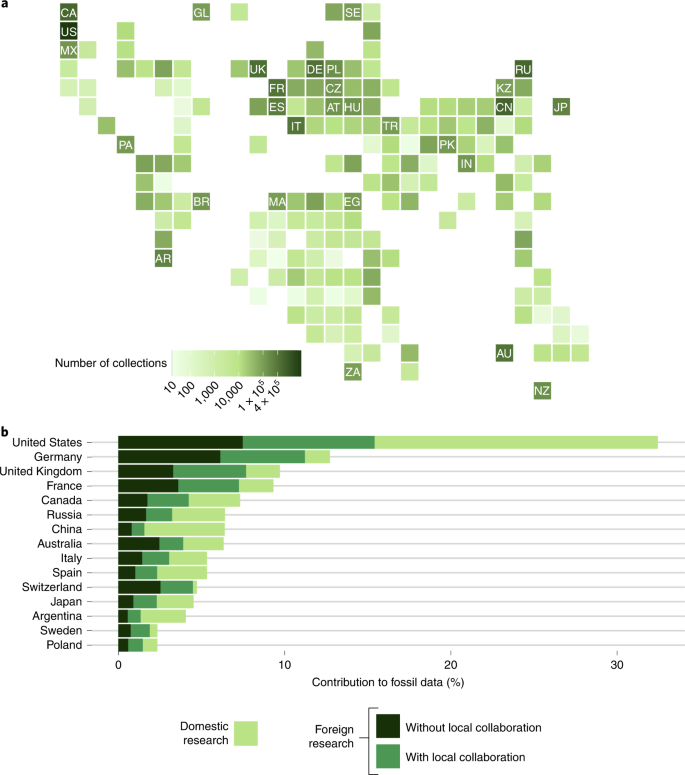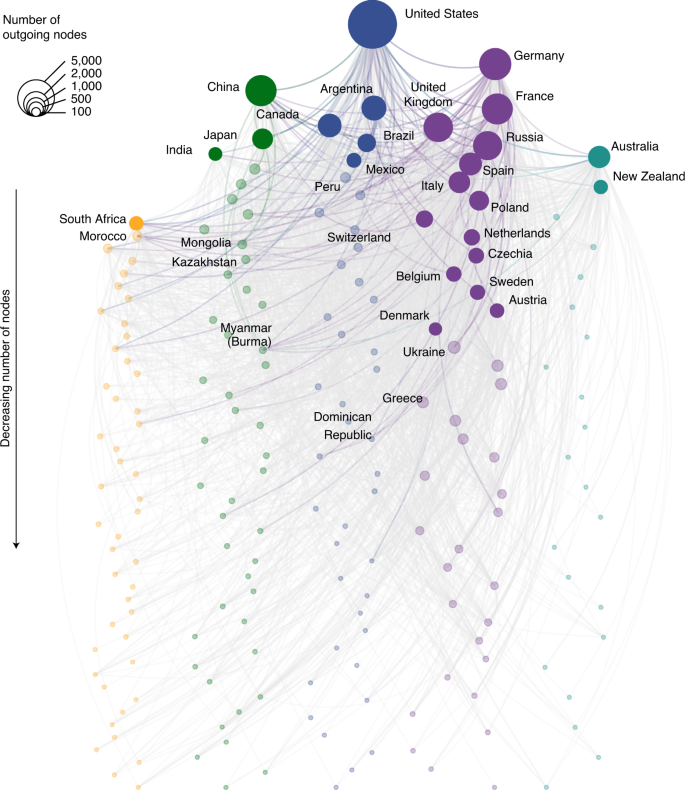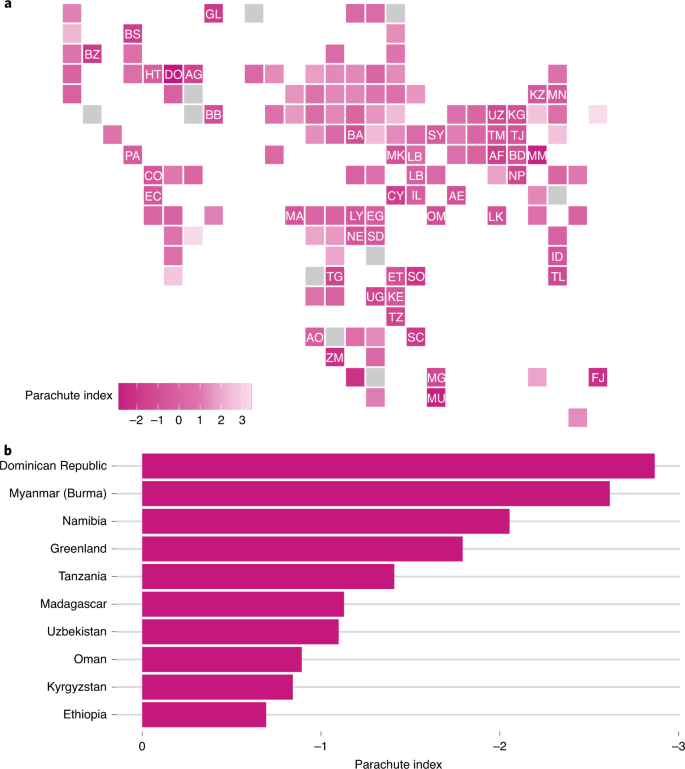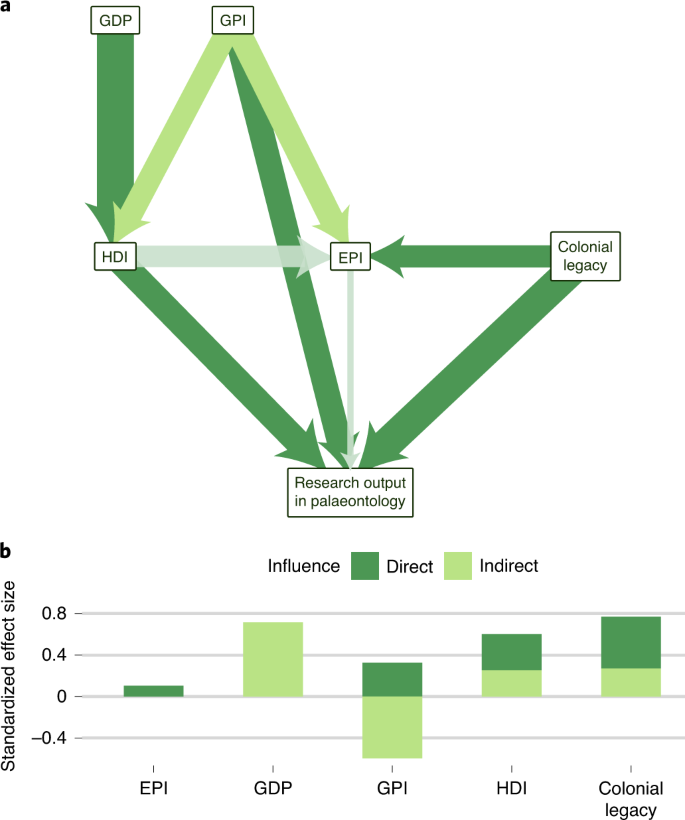Scientific colonialism in palaeontological research
We observe that palaeontological research represented in the PBDB is predominantly carried out by researchers affiliated with institutions located in high- or upper-middle-income countries; 97% of fossil occurrence data based on the publications catalogued in the PBDB was contributed by authors based primarily in northern America and western Europe (Fig. 1). This pattern is unsurprising, given the history of the discipline and the position of the US and the European Union as leaders in research and development expenditure20. Researchers based in the US, who contribute over a third of the total fossil data (Fig. 1b), appear to conduct a similar amount of domestic (that is, within the US) and foreign research (that is, outside of the US by US-based authors). The next top three contributors are researchers in Germany, UK and France, who are each responsible for more than 10% of the total fossil data, and conduct a disproportionate amount of research abroad compared with domestic research; almost half of the former does not involve any local researchers, that is, co-authors with in-country affiliations (Fig. 1b). Among the countries contributing to less than 10% of the fossil data, Switzerland stands out as a country with a high proportion (86%) of palaeontological research conducted in foreign countries. The ratio of domestic to foreign research for countries such as the US, Canada and Australia, as well as countries of Central and Latin America, almost certainly masks ubiquitous within-country colonialist research practices, given the small proportion of researchers from indigenous and other marginalized groups in academic spaces21,22,23,24,25. Similarly, for countries that are overseas territories of former colonialist powers, such as Denmark in the case of Greenland or France in the case of French Polynesia, the local indigenous population rarely, if ever, contributes to research based on localities in these regions (Supplementary Table 1 and Extended Data Fig. 1). As such, fieldwork carried out by non-indigenous researchers on colonized or occupied territories (many of which are controlled by the state or federal government) could also be considered a case of scientific colonialism26. This, however, cannot be quantified within the scope of this study, but should be considered along with the recommendations made at the end of this Article.
a, The number of fossil localities sampled in each country displayed on a tile grid map to avoid distorting the representation of the data that is typical of standard map projections. Two-letter country codes are shown for countries with greater than 10,000 fossil localities. b, Percentage contribution of the top 15 countries to the total fossil data analysed in this study. The colour of each bar represents whether the authors of each country conducted their research domestically (that is, in the same country), in a foreign country, or in a foreign country without collaboration with local palaeontologists. Two-letter country codes: AR, Argentina; AT, Austria; AU, Australia; BR, Brazil; CA, Canada; CN, China; CZ, Czech Republic; DE, Germany; EG, Egypt; ES, Spain; FR, France; GL, Greenland; HU, Hungary; IN, India; JP, Japan; KZ, Kazakhstan; MA, Morocco; MX, Mexico; NZ, New Zealand; PA, Panama; PK, Pakistan; PL, Poland; RU, Russia; SE, Sweden; TR, Turkey; UK, United Kingdom; US, United States; ZA, South Africa.
Among the top global data contributors, several countries conduct domestic research with low levels of contribution from foreign co-authors: China (75% of research is domestic), Argentina (66% domestic) and Japan (50% domestic) (Fig. 1b). In a skewed landscape where there is European and North American monopoly, these countries may initially appear as unexpected outliers, but not when their palaeontological research environment is further examined. These countries, along with India, Brazil and Mexico, are examples of ‘regional hubs of palaeontological knowledge’ (Fig. 2). In these ‘regional hubs’, most domestic research is carried out by local researchers (Extended Data Fig. 2) and the contribution of local researchers to these countries’ research output has been increasing over the past 30 years (Extended Data Fig. 3). Out of these countries, China is the most productive in terms of total research output (Fig. 1b and Extended Data Fig. 3). The establishment of palaeontology in China can be attributed to rapid geological surveying and mapping initiated in the 1950s, the excavation of several world-famous exceptionally preserved Lagerstätten and, recently, the enforcement of laws to retain Chinese fossils within the country (Supplementary Table 2). Similarly, palaeontology is a long-established discipline in Argentina, Brazil and Japan (Supplementary Table 2)—these countries have national palaeontological societies, universities offering palaeontology either as a standalone subject or as part of a wider programme, and national repositories for storing and curating these specimens on top of several funding opportunities for palaeontological research (Supplementary Table 2). These elements have a tremendous effect in shaping the culture and priorities in any discipline, palaeontology included, by acting as a catalyst for its advancement27. In the case of India, however, national funding agencies are less likely to provide funding for any work that involves fieldwork or research visits abroad (Supplementary Table 2), which is in contrast to many other countries where such rules do not exist. This represents a barrier to palaeontological research, especially when many Indian specimens are housed in foreign repositories but are inaccessible to Indian researchers because of travel restrictions. More recently, Brazil has been experiencing the same problems, due to the ongoing national political crisis and successive reductions in the country’s global scientific investment.
The chords represent connections between the country of authors’ institutional affiliations and the country the fossil material was collected from. The size of each country’s circle represents the number of publications on foreign fossil material, also represented by the number of outgoing chords. The countries labelled in bold represent countries with more than 30 outgoing chords, that is, the most popular ‘research destinations’.
World countries that experience a high incidence of parachute science and are exploited for their palaeontological data are primarily located in the Global South (Fig. 3a). We developed the ‘parachute index’ to quantify the extent to which countries are impacted by parachute science, on the basis of the log ratio of publications including local researchers versus publications not including any local researchers (Fig. 3). Many African countries are targets of parachute science (Fig. 3 and Extended Data Fig. 4), but only a handful of African countries have the infrastructures discussed above in place for palaeontological research (Supplementary Table 2). Most of the expertise around African fossils resides outside of the continent, with a clear link through colonial history to western European countries (Extended Data Figs. 3 and 5). For example, one quarter of all research conducted in Morocco, Tunisia and Algeria was conducted by French researchers, 17% of research on fossils from Tanzania was conducted by German researchers, and 10% of research on South African and Egyptian fossils was conducted by British researchers. However, researchers from western Europe do not restrict themselves to conducting research in their respective former colonies (Extended Data Fig. 5). Rather, their scientific focus, along with that of the US, is spread globally.
a, The parachute index of world countries, where tiles assigned to a country’s code indicate those countries that are mentioned in publications by solely foreign researchers (that is, no local collaboration) b, The 10 countries (with more than 30 publications in our dataset) that are the worst impacted by parachute science. Negative values indicate greater presence of parachute science, that is, research by foreign researchers that does not involve any local collaborators. Light grey tiles represent countries with no available data. Two-letter country codes: AE, the United Arab Emirates; AF, Afghanistan; AG, Antigua and Barbuda; AO, Angola; BA, Bosnia and Herzegovina; BB, Barbados; BD, Bangladesh; BS, the Bahamas; BZ, Belize; CO, Colombia; CY, Cyprus; DO, the Dominican Republic; EC, Ecuador; EG, Egypt; ET, Ethiopia; FJ, Fiji; GL, Greenland; HT, Haiti; KG, Kyrgyzstan; ID, Indonesia; IL, Israel; KZ, Kazakhstan; KE, Kenya; LB, Lebanon; LK, Sri Lanka; LY, Libya; MA, Morocco; MG, Madagascar; MK, Republic of North Macedonia; MM, Myanmar; MN, Mongolia; MU, Mauritius; NE, Niger; NP, Nepal; OM, Oman; PA, Panama; SC, Seychelles; SD, Sudan; SO, Somalia; SY, Syrian Arab Republic; TG, Togo; TJ, Tajikistan; TL, Timor-Leste; TM, Turkmenistan; TZ, Tanzania; UG, Uganda; UZ, Uzbekistan; ZM, Zimbabwe.
Neocolonialism—whereby extractive research practices developed during European colonial expansion in the nineteenth and twentieth centuries are maintained in the current century by other parties not previously involved in the colonizing agenda—is also apparent from our data. For most of the past three decades, the majority of China’s research has been led by local researchers (Extended Data Fig. 3). This focus has shifted in recent years, with a sharp increase observed in the number of publications on fossils collected abroad and no apparent local collaboration or engagement (Extended Data Fig. 3). This switch can be linked to an increasing interest in fossils from Myanmar, especially organisms preserved in amber (Extended Data Figs. 6a, 7). Similarly, Japan has shown an increase in research on Myanmar fossils in the past 10 years, although Japan’s geographical focus has generally been wider than China’s, with Japanese researchers conducting work not only in Asian countries (China, Mongolia, Thailand), but also in the US and Russia (Extended Data Fig. 5b). In contrast, the palaeontological research of South African and Argentinian researchers has remained mostly regional, that is, in Southern and Eastern Africa and South America, respectively (Extended Data Figs. 3, 6). Some publications by South African researchers on fossil specimens beyond the South African territory came as part of collaborations with countries such as the US (conducted in Tanzania), and the UK and Russia (both in Botswana).
Countries such as Myanmar, the Dominican Republic, Morocco, Mongolia and Kazakhstan are some of the most popular ‘research destinations’ for foreign researchers, thereby being the greatest targets of parachute science and scientific colonialism (Figs. 2 and 3). In the case of Myanmar and the Dominican Republic, the availability of commercial amber with fossil inclusions has increased the accessibility of this material to foreign researchers28, which has led to a high number of publications where there is no involvement from local researchers, indicating a clear example of parachute science29 (Fig. 3 and Extended Data Fig. 3). In Morocco, Mongolia and Kazakhstan, vertebrate fossils seem to be driving this same trend (Extended Data Fig. 7). Vertebrates, whether modern or fossil, enjoy more popular interest than other groups, usually leading to larger financial incentives in terms of funding30,31. As such, it is not surprising that vertebrate fossil deposits in many countries tend to attract the attention of foreign researchers. In fact, Mongolia and Morocco, along with other countries such as China, Mexico and Brazil, have been the victims of fossil trafficking and parachute research, especially vertebrate fossils, for decades. Similarly, issues of legality and ethics surrounding Myanmar amber have not deterred researchers from pursuing their endeavours in the field29.
Mechanisms causing knowledge imbalance in palaeontology
Our results confirm that, on a global scale, socioeconomic and political factors are some of the dominant controls on palaeontological research output (Fig. 4). The human development index (HDI), which represents different socioeconomic factors, such as life expectancy, education and standard of living, has a significant positive relationship with research output (r = 0.35, P < 0.05; Fig. 4). In turn, HDI is directly linked to the gross domestic product (GDP; r = 0.71, P < 0.05) of a country and its political stability (global peace index, GPI; r = −0.28, P < 0.05) (Fig. 4). Similar patterns are observed for countries that could not be included in the model due to data deficiency (Supplementary Table 1), where authors from these data-deficient countries classified as high- or upper-middle-income countries had a higher number of publications (Extended Data Fig. 1). Increasing GDP often results in increased investment into different sectors such as health, education and research and development, thus giving palaeontologists from high-GDP countries a broader set of tools and resources to advance the discipline locally (Supplementary Table 2). This has probably aided the establishment of ‘regional hubs’ beyond northern American and European countries in the form of emerging economies such as China, India, South Africa, Argentina and Brazil.
a, Path diagram of socioeconomic factors and colonial legacy influencing palaeontological research output. Dark and light green paths represent positive and negative influences, respectively. Paths for which P > 0.05 are semi-transparent. Path thickness is proportional to the standardized regression coefficient. b, Direct and indirect effects of each of these factors. Acronyms for socioeconomic measures: EPI, English proficiency index; GDP, gross domestic product; GPI, global peace index; HDI, human development index.
European ideologies and culture permeate science32. They are not only restricted to previous colonial powers, but are rather ubiquitous across academic structures and political borders, leading to the discrimination and exclusion of marginalized groups that do not conform to this system33. Our results show that this colonial legacy (measured here by a binary variable indicating whether a country has benefitted from colonialism; Supplementary Table 3) has the greatest impact on research output in palaeontology (r = 0.50, P < 0.05; Fig. 4). This relationship is not unexpected, given the roots and history of the discipline. However, the fact that this is apparent in data collected in the past 30 years suggests that the power dynamics currently observed in the discipline are still analogous to the ones that existed during the age of colonial plunder. Modern palaeontology, like most of the natural sciences, was built on an exploitative system that was the European colonization process – one centred on making highly asymmetric profits – which benefitted the colonizers at the expense of the colonized34. The colonial legacy that is reflected in the natural history collections of many of these countries has been at the forefront of many recent discussions35,36,37. Some countries beyond western Europe and northern America, namely China and South Africa, also have their own (neo-)colonial legacy (Supplementary Table 3). Additionally, in modern times, educational institutions and private companies, rather than the nation state, benefit from existing and new colonial structures38.
In several countries, national political and legal frameworks, through the formulation and enforcement of fossil heritage laws, have promoted local research endeavours39. Many countries (for example, Argentina, Brazil and China) restrict exports of fossils to other countries (Supplementary Table 2), meaning that these specimens remain in local repositories that can be accessed more easily by local palaeontologists for research purposes, as compared to when they are reposited in foreign collections. This is especially observed in the case of Brazil, where the stricter enforcement of laws since the 2000s in an attempt to curb this issue has led to increased contributions in terms of the number of publications by Brazilian scientists (Extended Data Fig. 3). In addition, there are laws that regulate research undertaken by foreign researchers, usually by stipulating a requirement for a local collaborator (Supplementary Table 2), which has resulted in an increase in collaborations with local palaeontologists in these countries (Extended Data Fig. 3). However, in the case of Myanmar and the Dominican Republic, the commercialization of amber with fossil inclusions has increased access for researchers from higher-income countries despite the presence of legislation restricting amber or fossil exports, which in turn restricts access for local researchers unable to afford the material29,40.
The relationship between research output in palaeontology and proficiency in the English language, as measured by the English proficiency index (EPI; Fig. 4), is unsurprising given the reliance of palaeontology, and academia more widely, on literature in English, and is another representation of how academia is entrenched in the colonial process. English is the ‘lingua franca’ of science and today it dominates peer-reviewed scientific publications across all research fields41. Approximately 92% of publications recorded in the PBDB published between 1990 to 2020 are in English, with Chinese, German, French and Spanish making up the majority of the remainder (Extended Data Fig. 8). This monopoly of English-language knowledge has serious consequences for palaeontology, by disadvantaging researchers for whom English is a secondary language or who are based in countries with low English proficiency, making non-English-language knowledge inaccessible, and impeding the communication of science to under-represented communities42,43,44,45,46. This English-language bias is particularly consequential for palaeontological research that relies on compilations of primary studies, as previous work has suggested that ignoring non-English-language studies may bias outcomes of ecological meta-analyses47. One simple, yet rarely adopted, solution for palaeontologists would be to actively seek out non-English knowledge during literature searches, which should be implemented through collaboration with native speakers of these languages47,48. Similarly, palaeontological journals are increasingly providing authors with the option to submit their manuscript abstracts in multiple languages48,49.






